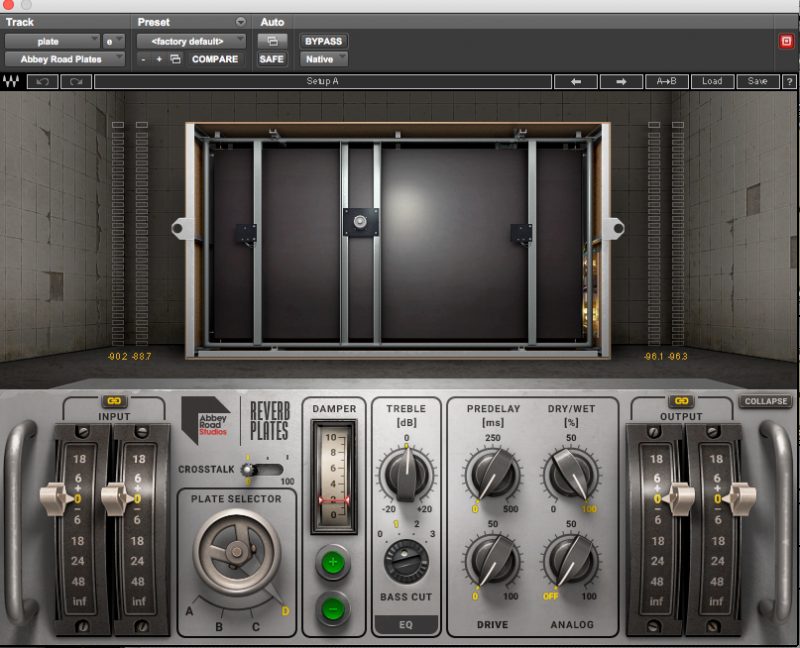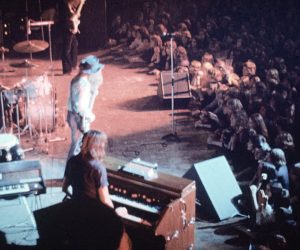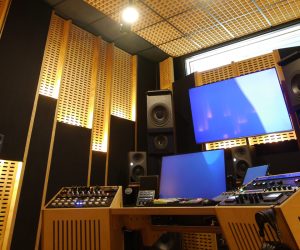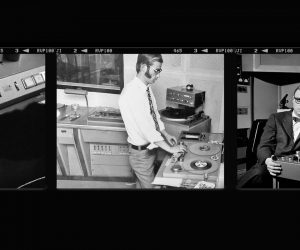
Remixing Abbey Road: 50th Anniversary Edition
When it came time to make the 50th Anniversary remixes of The Beatles’ classic Abbey Road, producer Giles Martin and engineer Sam Okell were tasked with carrying the weight of its history over the lines.
The heritage rock industry is dominated by ‘boxed set’ re-releases of iconic rock albums from the ‘60s and ‘70s, with all manner of enticing add-ons thrown in: session outtakes, previously unreleased live tracks, original tracks remastered, sometimes remixed and sometimes even enhanced with new overdubs. Of course, it all comes packaged with spectacular artwork, hitherto unseen photos, new essays, interviews and more. There have been boxed sets by Bob Dylan, Led Zeppelin, Pink Floyd, The Beach Boys and many more. The Beatles have joined the melee but their boxed sets have become more controversial than most because their albums have achieved iconic status; making any changes brings to mind the proverb about repainting the Sistine Chapel.
Here we are in 2019 with three massive boxed sets to date, marking the 50th anniversaries of Sgt. Pepper’s (2017), The White Album (2018), and Abbey Road (2019) respectively. Great packaging and session outtakes are par for the course, of course. The controversial bit is that repainting has indeed taken place, in the form of remixing the original album tracks in Pro Tools. Screams of ‘sacrilege’ have been muted, however. Reactions from fans and critics alike have been overwhelmingly positive and this obviously has to do with the quality of the remixes, which were conducted by producer Giles Martin (son of George Martin) and engineer Sam Okell.
SERGEANT PEPPER’S…
Following the release of the Anniversary Edition of Sgt. Pepper’s Lonely Hearts Club Band in May 2017, Giles Martin explained that the impetus for the remixes came in 2015 when he and Okell were invited by the remaining Beatles to make 5.1 remixes of the tracks on the 1 album (a compilation of The Beatle’s number one hits) that had music videos. In the process, Martin and Okell also did stereo remixes that were received with all-round applause. This, said Martin, “gave us the confidence that we could successfully remix Sgt. Pepper’s.”
There were additional justifications for the remix of Sgt. Pepper’s, explained Martin. “With Sgt. Pepper’s, the band was far more focused on the mono version. The team spent three weeks mixing to mono, which was done with the band present, and only three days mixing the stereo version – and the band was not even there! If you compare the mono and the stereo versions, they are very different. John Lennon once said that you hadn’t properly heard the album unless you heard the mono version. Plus, the original stereo mixes have some major flaws, like songs being played back at the wrong speed. So we decided to create new stereo mixes, using the mono mixes as our template. We felt that we could create the stereo mixes the band would have wanted 50 years ago, while also trying to break some new ground by improving the mixes for modern ears.”
Furthermore, Sgt. Pepper’s was recorded on a four-track tape recorder with producer George Martin and engineer Geoff Emerick regularly bouncing to new generations of tapes. With the first generations of tapes still available, Martin and Okell could go back and load first generation material into Pro Tools, thereby not only improving sound quality but also providing the ability to separate parts that had been previously bounced together out of necessity.
THE WHITE ALBUM…
Some good justifications were given for remixing Sgt. Pepper’s. One wonders what justifications Giles and Okell had for remixing The White Album, and how they compare with remixing Sgt. Pepper’s.
“Some of the songs on The White Album were recorded on a four-track Studer J37, others on an eight-track Studer 3M” replies Okell. “But there were far fewer overdubs on that album, so there were fewer bounces, which made the whole process easier than Sgt. Pepper’s. It was mixed in stereo and mono, but the differences between those mixes were not as pronounced as they were with Sgt. Pepper’s.”
“The thing about The White Album is that the tracks are all so different. It’s far less of a production album than Sgt. Pepper’s, or Abbey Road for that matter. The concept of remixing Sgt. Pepper’s was neat and valid and easy to explain, but with The White Album it was a song-by-song thing. We were just trying to keep the character of each song, with the entire album being a collection of them.”
ABBEY ROAD
In contrast to Sgt. Pepper’s and The White Album, Abbey Road was the first Beatles album that was recorded entirely on eight-track, and for which no mono mixes were done. Moreover, the recordings, the production, and the stereo mixes were top class, making the album sound almost like a modern record. Of the three anniversary editions, the notion of remixing Abbey Road would have to come the closest to the notion of repainting the Sistine Chapel and raises the question: why?
“The original album does sound great,” agrees Okell. “The stereo positioning is pretty modern, with most lead vocals in the centre, for example, and there were no major technical issues that needed fixing. After we had remixed Sgt. Pepper’s and The White Album, Apple Records [the Beatle’s record label] was indeed concerned about whether it would be worthwhile remixing Abbey Road. So Giles and I had a go to see what would happen, and whether it was justified. We ended up making changes that are far more subtle than those that you hear on Sgt. Pepper’s, but we felt that they were valid. There are many subtle changes in the balances and positioning, and we expanded on many of the mono sources that are hard panned and hard positioned, in order to try to create a more cohesive stereo image.”
We had some mix notes, but for the most part we had to recreate the original mixes using our ears.
TRANSFERRING ABBEY ROAD
As with the other albums, the first step of the remixing process for Abbey Road was to transfer all the original analogue tapes to Pro Tools. “All tapes were running at 15ips, which means each tape can contain about 28 minutes of material,” explains Okell. “Each tape has successions of different takes including the initial takes, the take that was used for the final mix, and numerous overdubs and bounces. We also had two different test tapes — CCIR and MRL — to align the tape machines; one sounding slightly brighter than the other. So we did numerous transfers from each tape. The first transfers were of the entire tapes, which gave us all the bounces, alternative takes and so on to refer to and perhaps even use – allowing us to go back a generation or two as we did with Sgt. Pepper’s and The White Album.”
The next transfers were a little more complicated, as Okell explains: “The speed those old tape machines run at depends on the fluctuating voltage of their power supplies; one day they would run a tiny bit faster or slower than another day. These were tiny fluctuations, not like with Sgt. Pepper’s where there were sometimes differences of a semitone. For speed references we decided to use the earlier 2009 remasters of Abbey Road, that I’d been involved in making, because our idea for the 50th anniversary version was the same as our idea for the 2009 version: we wanted to get as close as possible to what it sounded like at the time in terms of speed and pitch. So for these transfers we created a Pro Tools session for each song, and at the top of that session we loaded in the 2009 stereo remaster of that song as a sync reference. Then we’d go through the original tapes, find the take that the final mix for that song was built from, and transfer that into the session in sync with the 2009 remaster.”
“Because Abbey Road was all recorded on eight-track they were able to do a lot of bouncing of tracks internally on to that one tape. In many cases they then deleted the original tracks to make room for more tracks, which meant that we could not go back a generation. In some cases they worked with two eight-track recorders, or a combination of an eight-track and a four-track recorder, bouncing from one tape to another, and those tapes did enable us to go back a generation to get separate tracks, like we did with Sgt. Pepper’s.”
![[[03]]](https://www.audiotechnology.com/wp-content/uploads/2019/11/03.jpg)
REMIXING ABBEY ROAD
After all the tapes were transferred into Pro Tools, Giles and Okell tried to approximate the original mix of each song as closely as possible in terms of levels, panning, EQ, compression, delays, reverbs and other effects. This involved many hours of close listening and comparing. When they did the Sgt. Pepper’s remixes they used a lot of the same outboard gear that was used for the original mixes, including the classic REDD valve mixer that was used at the time, along with some some choice plugins. According to Okell, things were different for the Abbey Road remixes.
“We had some mix notes, but for the most part we had to recreate the original mixes using our ears. We did the Abbey Road mixes in-the-box, and treatments tended to be more plugin-based than analogue-based because we were not looking for a lot of extreme processing. We often used plugin approximations of vintage gear. What we had with this album were good sounding recordings; when we simply played back the basic sessions we got a pretty good representation of the final mix. So what we had to do for Abbey Road was more subtle than Sgt. Pepper’s or The White Album: how can we improve the tonal qualities of some of the sounds, and how can we improve the stereo sound stage? These subtle changes could, for the most part, be achieved by using plugins.”
Two years earlier, when remixing Sgt. Pepper’s, Martin and Okell relied heavily on vintage goodies like EMI’s RS124 compressor and RS127 Brilliance Control, Fairchild’s 660 compressor, EMT’s 140 plate, and the studio’s REDD desk. They also used a process called ADT (Artificial Double Tracking) – a technique devised by Abbey Road engineer Ken Townsend that involved two tape recorders playing back two identical signals, with the varispeed of one of them used to vary the playback speed by a few milliseconds to create a phasing or ‘wobble’ effect (depending on how much varispeed is applied). For the Abbey Road remixes the only hardware Giles and Okell used were an EMT 140 plate, the tape recorders required to recreate the ADT effect, and the REDD desk – the latter because the original Abbey Road sound engineer, Geoff Emerick, felt that the transistorized TG12345 desk had a less punchy sound, contributing to a “kinder, gentler” feel.
According to Okell, “Geoff has said that he couldn’t get quite the same sound with the TG desk as with the REDD desk. The TG is a very good desk; it’s cleaner, but it does not overdrive in the same way as the REDD desk does. The REDD also has a different approach to EQ, with just a high shelf and a low shelf, and you tend to max these out and get this big ‘smiley face’ EQ curve. So for many of the songs on Abbey Road we ran individual parts through the REDD desk, sometimes EQing and sometimes overdriving them to different degrees to get some of that character that might have been missing in the original mixes of Abbey Road due to being mixed through the TG. That was quite effective.”
“On Sgt. Pepper’s they were into using the ADT for the phasing effect, most famously on John’s vocal in ‘Lucy In The Sky With Diamonds.’ For Abbey Road they were more in love with the wobble effect, for example on the Moog synth sounds. There is no real plugin equivalent for ADT. There’s Waves’ Reel ADT plug-in, which is fine for when you want a general phasey sound but it is too much of a sledgehammer if you want to do very detailed stuff, such as vary a very small amount of delay. If you do ADT with analogue tape machines you can control it as you print it, and if something does not sound right you can go back and do it again. It’s amazing that the tools they had at the time, apart from EQ and compression, were all tape-based – from simple tape delays to the psychedelic comb filtering effect that you get with very close ADT.”
“Vocals were an important part of our focus during all of these remixes. The lead vocal for ‘Here Comes The Sun’ is fuller and louder than in the original, and we think it sounded better. We did the same thing on ‘Something,’ pushing the lead vocal to be decidedly louder – it seemed oddly quiet on the original. And on ‘Oh Darling’ we did quite a bit of work with FabFilter’s ProQ to make Lennon’s lead vocal less harsh. It makes the song more attractive.“
“All mixes for all the songs were sent to the Stereo Process aux, which is the master track. The signal chain was Waves Redd 37/51, UAD Chandler Abbey Road Curve Bender Mastering EQ, a Kush Audio UBK1, FabFilter Pro-Q2, Waves SSL Bus compressor, Waves Abbey Road TG12345 channel strip, UAD Studer A800 emulation and a UAD Fairchild 660, with the settings tweaked per song. I printed each mix at the top of the session and sent it to Miles Showell, who mastered the album with Giles present. We weren’t too bothered about the mixes needing to be loud in general, or being louder than the 2009 master. When you compare our remixes to any contemporary stuff, they are way quieter. It is not about loudness!”
Instead, as Giles Martin had noted earlier, the remixes were about “improving the mixes for modern ears.” Whether any of the “trying to break some new ground” approaches taken on the Abbey Road remixes will meet with universal approval, or finally have the purists up in arms about ‘repainting the Sistine Chapel’, will be clear by the time you read this…













![[[02a]]](https://www.audiotechnology.com/wp-content/uploads/2019/11/02a-e1574054543270.jpg)















Er … pretty sure Paul McCartney sang (and wrote) “Oh Darling”. It’s the stuff of recording legends after all. Him coming into the studio for days on end to try to nail that vocal. He walked in apparently, as he lived nearby.
Quite right. Lennon is quoted as saying he wished Paul had let him sing it because he thought he’d have done a good job.
I’m def. not a hater of these projects, I love the original versions, the remasters, all of it really. It’s not like the older masters are going away. But man these remixes over the last couple of years feel like they’ve been done with a LOT of love, care and bravery. I’ve enjoyed every second, and I can’t wait to see what they work on next!!